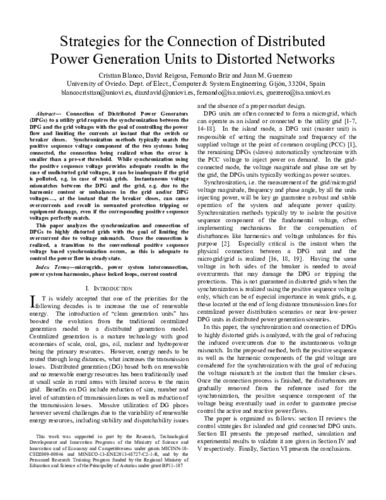Strategies for the connection of distributed power generation units to distorted networks
Autor(es) y otros:
Fecha de publicación:
Editorial:
IEEE
Versión del editor:
Citación:
Descripción física:
Resumen:
Connection of distributed power generators (DPGs) to a utility grid requires the synchronization between the DPG and the grid voltages with the goal of controlling the power flow and limiting the currents at instant that the switch or breaker closes. Synchronization methods typically match the positive sequence voltage component of the two systems being connected, the connection being realized when the error is smaller than a preset threshold. While synchronization using the positive sequence voltage provides adequate results in the case of undistorted grid voltages, it can be inadequate if the grid is polluted, e.g., in case of weak grids. Instantaneous voltage mismatches between the DPG and the grid, e.g., due to the harmonic content or unbalances in the grid and/or DPG voltages..., at the instant that the breaker closes, can cause overcurrents and result in unwanted protection tripping or equipment damage, even if the corresponding positive sequence voltages perfectly match. This paper analyzes the synchronization and connection of DPGs to highly distorted grids with the goal of limiting the overcurrent due to voltage mismatch. Once the connection is realized, a transition to the conventional positive sequence voltage based synchronization occurs, as this is adequate to control the power flow in steady state
Connection of distributed power generators (DPGs) to a utility grid requires the synchronization between the DPG and the grid voltages with the goal of controlling the power flow and limiting the currents at instant that the switch or breaker closes. Synchronization methods typically match the positive sequence voltage component of the two systems being connected, the connection being realized when the error is smaller than a preset threshold. While synchronization using the positive sequence voltage provides adequate results in the case of undistorted grid voltages, it can be inadequate if the grid is polluted, e.g., in case of weak grids. Instantaneous voltage mismatches between the DPG and the grid, e.g., due to the harmonic content or unbalances in the grid and/or DPG voltages..., at the instant that the breaker closes, can cause overcurrents and result in unwanted protection tripping or equipment damage, even if the corresponding positive sequence voltages perfectly match. This paper analyzes the synchronization and connection of DPGs to highly distorted grids with the goal of limiting the overcurrent due to voltage mismatch. Once the connection is realized, a transition to the conventional positive sequence voltage based synchronization occurs, as this is adequate to control the power flow in steady state
ISSN:
Patrocinado por:
Ministry of Science and Innovation [MICINN-10-CSD2009-00046]; Ministry of Economy and Competitiveness [MINECO-13-ENE2013-48727-C2-1-R]; Personnel Research Training Program - Regional Ministry of Education and Science of the Principality of Asturias [BP11-107]
Colecciones
Ficheros en el ítem




